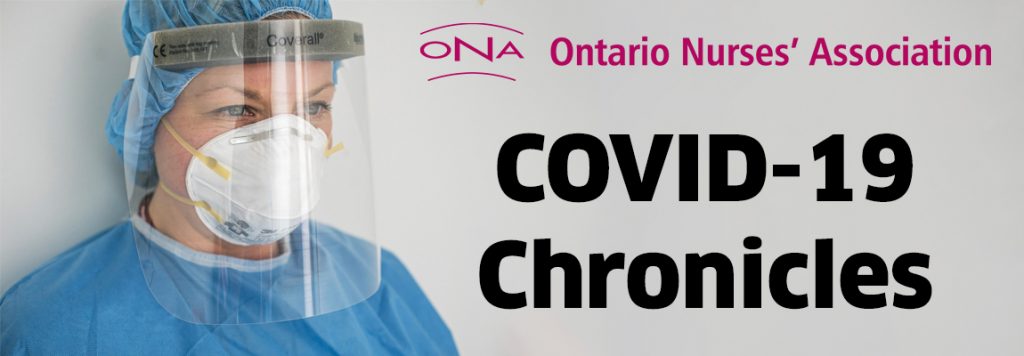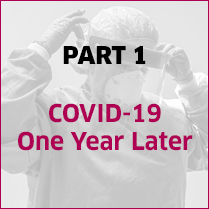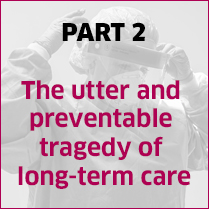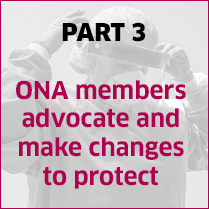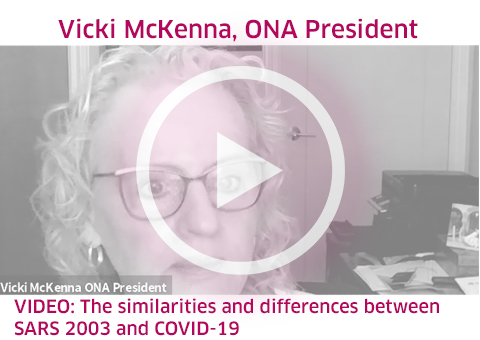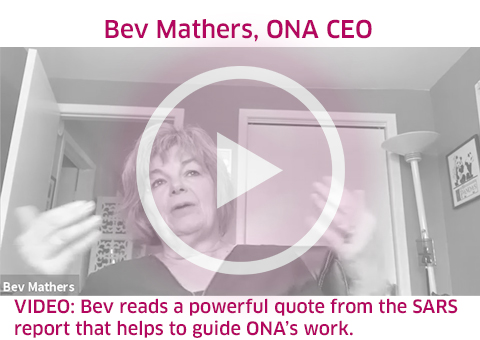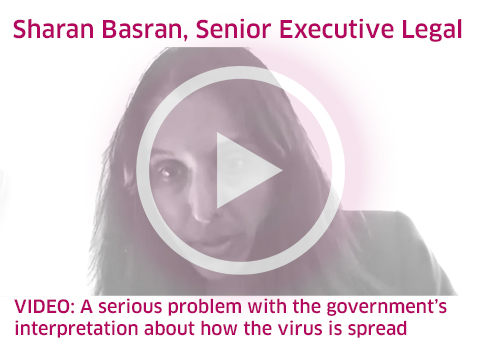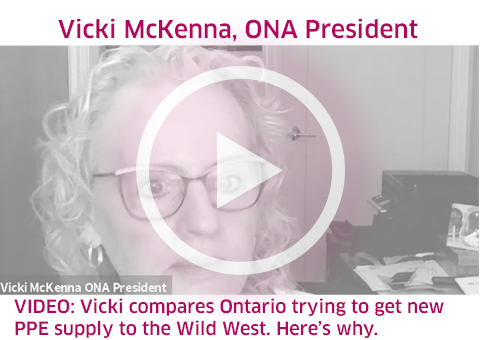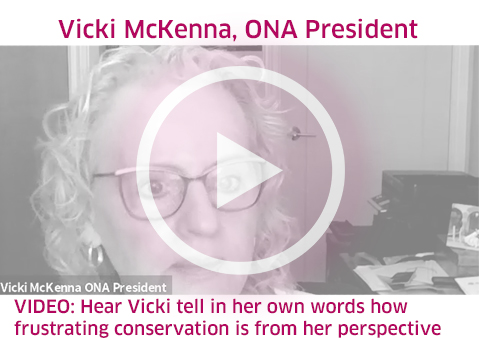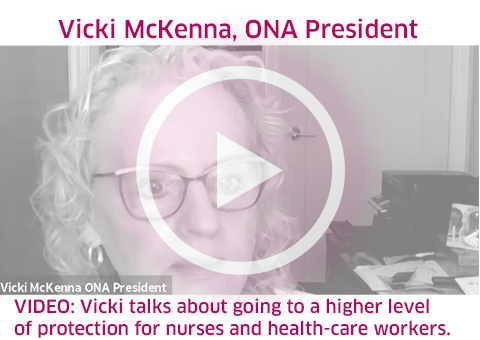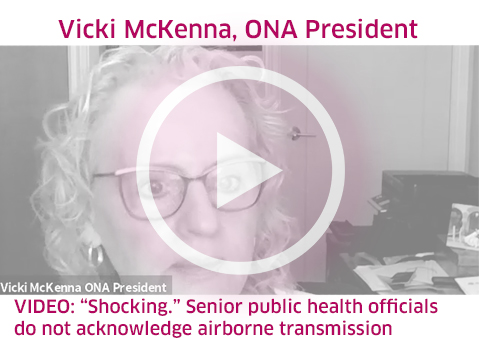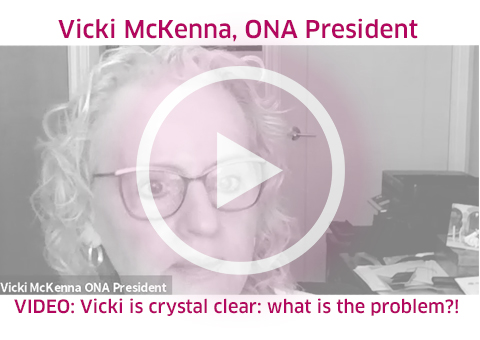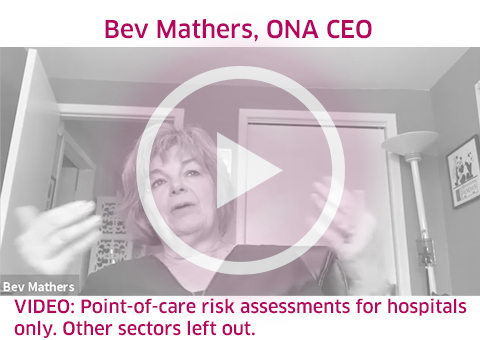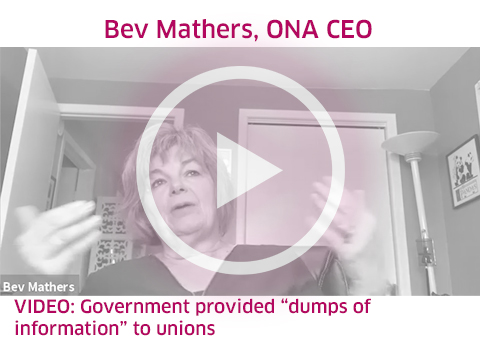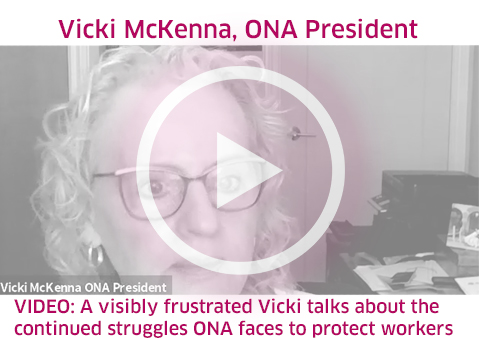One year ago, the World Health Organization declared a global pandemic, signifying a public health crisis that would turn the world upside down. In this web series, ONA examines the experiences of front-line members during COVID-19, how ONA was instrumental in protecting them and their patients, clients and residents, and the impacts of government decisions on Ontario’s health-care system. This past year has marked an extraordinary period in the life of ONA and our members.
ONA Leads
In 2003, after SARS finally ended in Toronto, Ontarians collectively exhaled with relief.
Two waves of SARS had hit that year, with 44 tragic deaths – including two ONA members – Tecla Lin and Nelia Laroza – both registered nurses. Hundreds of people were infected with SARS, and thousands were quarantined in and around the Greater Toronto Area.
Some registered nurses – those who were working in hospitals in 2003 – still vividly recall SARS. Some are still shell-shocked from the devastating experience. Who can really blame them? The health-care system was unprepared to deal with a novel illness like SARS with a lack of precautions in place to protect registered nurses, health-care professionals and patients. Hospital staff in the SARS hotspots were overwhelmed, guidance and directives from various federal and provincial health-care agencies were delayed and conflicted, and infection prevention and control procedures were in a state of decay. One key and ongoing concern was the availability and accessibility of PPE, particularly N95 respirators for health-care workers.
When SARS ended, governments proclaimed that something like this would not happen again. Health Canada launched a National Advisory Committee examining SARS, and identified several serious deficiencies related to disease surveillance, communications, infection control and infectious disease management, and more. The 234-page report produced by the committee detailed the urgent need to form the Public Health Agency of Canada, in part to identify threats and instill public health surveillance and structures to strengthen responses to future potential threats.
The government of Ontario launched the Ontario SARS Commission, led by the Honourable Justice Archie Campbell. The Commission investigated how SARS spread and how it was handled within Ontario’s health-care system. Among the many system-wide recommendations in the report, one underscored the vital need to use the precautionary principle – in other words, to err on the side of caution and not wait for scientific certainty to protect people. “That in any future infectious disease crisis, the precautionary principle guides the development, implementation and monitoring of procedures, guidelines, processes and systems for the early detection and treatment of possible cases.”
Thousands of pages of reports and studies, transcripts of interviews, articles in multiple journals, plans, procedures and policies were written with one main goal in mind: to prevent something as deadly and infectious as SARS from occurring again.
Fast forward to 2020.
Never again has become yet again.
SARS may be the last wake-up call we get before the next major outbreak of infection, whether it turns out to be an influenza pandemic or some other health crisis. That is why we cannot forget how bad SARS was, and how much terrible suffering and loss we must avoid the next time around. The tragedy of SARS, these stories of unbearable loss and systemic failure, give the public every reason to keep the government’s feet to the fire in order to complete the initiatives already undertaken to make us safer from infectious disease.
-SARS Report
“Shadow of Déjà Vu.”
As a staff nurse working during SARS 2003, ONA President Vicki McKenna vividly recalls her lived experience – as if it were yesterday. When she heard reports of this new coronavirus, McKenna thought it was like SARS 2003, but much bigger. “I knew it was going to be much bigger because of how global people are, how the virus was moving so quickly and how contagious it was, and the mode of transmission was not clear,” she says. “That really worried me a lot and I felt this shadow of déjà vu in protecting people, nurses and health-care professionals because this was so different.”
When asked about the 2003 SARS, ONA CEO Bev Mathers sits up straight and with laser focus says, “I remember when SARS started and, as soon as I heard about this new coronavirus, I immediately flashed back to SARS. This was going to be a problem.”
ONA Prepares
January 2020 dawned with many serious rumblings in the news about this new coronavirus and its capacity for easy transmission. Immediately, McKenna and Mathers contacted Christine Elliott, Minister of Health, telling her that ONA was very concerned about this new coronavirus, and looking for information about the government’s plans to manage and contain it. “Is the health-care system ready?” they asked.
Will we be able to manage overcapacity and RN staffing levels when further cases are confirmed? Have workplaces performed risk assessments and do they have isolation rooms for COVID-19 cases? Are there plans in place to address the shortage of space and shortage of staff? Who is the point person at the Ministry of Health to escalate our concerns, such as employers not complying with safety protocols?
The government had a simple response to ONA’s many valid concerns: We are aware of the situation. Period.
Immediately, Mathers “dusted off” the 2003 SARS files and recommendations and consulted with ONA health and safety specialists and other ONA staff. It became apparent quite quickly that ONA needed to turn its immediate attention to prevention, containment and helping our members protect themselves and their patients, residents and clients. ONA launched regular staff meetings via Zoom to keep everyone informed of the latest information and directives from government. Staff email inboxes began to fill up with the many issues that began to take over Ontario. And the 2003 SARS files became the foundation for ONA’s response throughout this pandemic.
Hospital Sector Preparedness
Early in 2020, ONA’s legal team – led by Senior Executive, Legal Sharan Basran – started to prepare for potential litigation in the hospital sector. Basran notes, “We were noticing an overall lack of preparedness and although proper PPE is a key component, there is so much more, including worker safety, regular Joint Health and Safety Committee (JHSC) meetings, ensuring proper infection control procedures are followed, cohorting and isolation were in place and more.”
Basran points out that ONA’s collective agreement language “needed to be respected” to address the precautionary principle yet the government had a narrow perspective of how COVID-19 spread and ignored aerosol transmission. Its interpretation had long-lasting effects on what employers were mandated to do to keep workers safe. For instance, employers weren’t directed to look at ventilation, engineering controls, policies to address workers staying off work while ill with presumptive or suspected COVID-19, and ultimately the level of PPE required, which proved to be vital to members and all health-care workers’ safety.
“In those early days, it was really fighting with employers that were abandoning the precautionary principle, and it started in the hospital sector,” Basran explains.
Personal Protective Equipment Problems
At every single opportunity, ONA raised all of these issues and others with government officials. Yet there was one potential catastrophe waiting in the wings to be unveiled: problems related to insufficient supply of PPE.
In the beginning, McKenna was a participant on the government tables looking at a host of urgent issues, including the availability of PPE in the province and throughout Ontario’s health-care workplaces. She noted early on that something was amiss.
“At the provincial tables, I asked, ‘What is the pandemic supply like? Is it regularly inspected? What is the situation?’ And the government replied, ‘We have a supply and we’re working on it.’ And that was my first clue when I started to feel very uneasy. There should have been an answer that day and I knew that there was a problem,” McKenna explains. What we now know is that Ontario scrambled and was in a free-for-all for medical supplies. There were even stories of Ontario officials having to meet suppliers on airplane tarmacs in other countries to get the needed supplies, only to be outbid right then and there by others.
ONA reached out and asked its hundreds of leaders on the ground to canvass their employers about their pandemic preparedness plan and their stockpile of supplies. What were the numbers of gowns, gloves, masks, and N95 respirators? How many weeks – or days – of supplies were available to front-line workers? Immediately, ONA members raised many alarm bells to McKenna.
The details made McKenna very uneasy: workplaces did not have enough or any pandemic supply stockpiles. What supplies some workplaces did have were often expired, moldy or covered in dirt or leaves because they were kept in storage units outside. The stories from our members about lack of supplies continued and the details were immediately relayed to the government. We now know that the provincial pandemic stockpile – something that should have been on hand and readily available – was not. In fact, only 10 per cent of the stockpile remained and even that equipment was specific for Ebola outbreaks. The remaining 90 per cent of the stockpile had been destroyed or had expired. This was a catastrophe.
In April of 2020, the PPE supply became so low (only five days of supply left) that there was a public appeal from Premier Ford to all industries, asking them to donate their supplies and equipment to front-line registered nurses and health-care professionals. In fact, ONA issued its own statement echoing the need for donations.
Conservation Efforts
During the first wave of COVID-19, there were many instances in which ONA members were given a limited supply of PPE for their shifts: one surgical mask or one N95 respirator, for example. Some workplaces gave workers paper bags so that when their shift was over, they could place their mask in the bag and use it again for the next shift. ONA heard dozens of these horrific stories – horrific because nurses and health-care professionals were questioned by their employers repeatedly about the need for “yet another mask or yet another pair of gloves.” Regrettably, these pressures from some employers continue with this same line of aggressive questioning to this day.
“In this day and age with health-care worker infections, people should have the right to make that clinical judgement and then not be questioned by other people constantly or denied the mask,” states McKenna.
Precautionary Principle: Reaction from Public Health Officials
From the beginning, ONA has taken the position that employers must take precautions based on the presumption that COVID-19 is an airborne virus and can also be transmitted asymptomatically.
“The interpretation of the precautionary principle was shocking or simple in my view because unless the science is clear, you err on the side of caution,” McKenna explains.
Justice Campbell’s SARS Commission called for the concerns of health-care workers to be taken seriously so they feel safe, even if that requires higher levels of precautions.
Some senior public health officials – to this day – refuse to acknowledge that COVID-19 is airborne, which McKenna calls “shocking.” If the Chief Medical Officer of Health would acknowledge that there could be airborne transmission, then our members would not continue to face difficult situations in accessing PPE, including N95s.
McKenna notes, “I do not for the life of me understand why there is such resistance to a higher level of protection, what is the problem? … We have never had such carnage nor these numbers of health-care worker illnesses.”
Questions about whether COVID-19 is airborne resulted in some nurses being denied N95 respirators in place of surgical masks, and other PPE was also denied. This was a problem that had to be addressed immediately.
Directive #5
During marathon sessions over the weekend of March 28 and 29, 2020, ONA and the government agreed to new measures that clarified the use of PPE in hospital settings while committing to conservation and stewardship.
“We had spoken out, loud and clear, at government tables that protecting the health and safety of nurses is paramount and we welcomed these new measures for the hospital sector,” McKenna says. “This enabled nurses to use the precautionary principle to prevent exposure to and transmission of COVID-19, something that ONA had been advocating for from the start.”
With these new measures, nurses were empowered to determine – based on their professional and clinical judgement – when they required access to PPE, such as an N95 respirator to care for a suspected, presumed or positive COVID-19 patient. The Directive stated that the employer could not unreasonably deny access to this PPE. In addition, a point-of-care risk assessment was to be performed before every patient interaction to ensure hospital front-line registered nurses were properly protected.
McKenna is clear on who drove this Directive: “This would not have been possible without thousands of our front-line members speaking out and telling their stories to ONA.”
Although this was a positive step for the hospital sector, other health-care sectors should have been included in this directive from its inception, such as long-term care, public health, community care, and home care.
Mathers says she was told that Directive #5 would be rolled out to nurses in hospitals first, with other health-care workers and sectors immediately following. Unfortunately, this was not the case. In fact, it was in October when Directive #5 was expanded to include different sectors and health-care workers, something Mathers says was unacceptable: “It should have happened right away.” No health-care worker is expendable; everyone deserves to be protected equally.
“Government consultations did not exist”
Throughout the pandemic, this government has failed to reach out to ONA, other unions, registered nurses or health-care workers to learn from their experiences or knowledge of what was happening on the ground and to shape directives based on their clinical experience. It was almost as if the government took a bulldozer approach and initiated directives and policies without examining the short- and long-term consequences.
There were government meetings, but they were used to inform us of a decision in most cases rather than to collaborate on an issue in a meaningful way.
In fact, Mathers calls the government command tables, “fragmented and too many layers. There was no voice of front-line workers and everything that came from government was dumps of information. Consultation did not exist.”
“ONA is only a phone call or email away,” says McKenna. “We are willing to work with government at any time to help improve worker safety and protect our patients, residents and clients. We are here to help, and we will do whatever it takes to get the job done safely.”
ONA and COVID-19 Today
Today, Ontario continues to face COVID-19 with new variants of concern (VOC) emerging across the province. Vaccines are rolling out to Ontarians, though not quickly enough.
Unfortunately, ONA continues to have to fight employers just for the basic need to protect members and their patients, residents and clients.
“We are still trying to get employers to follow infection prevention and control measures, we are still having challenges with cohorting, we are still having challenges with ensuring availability of proper PPE, and people are still getting sick and dying. That is the tragedy of it all.”
